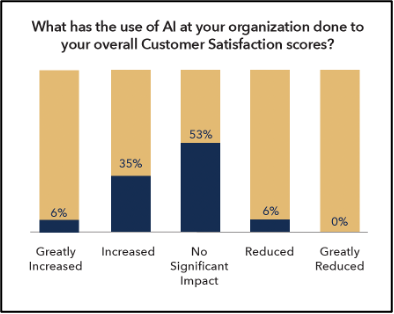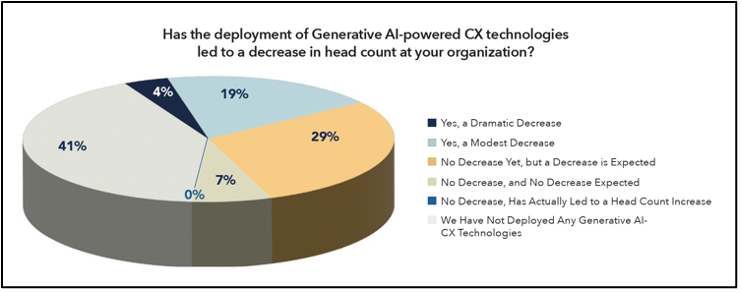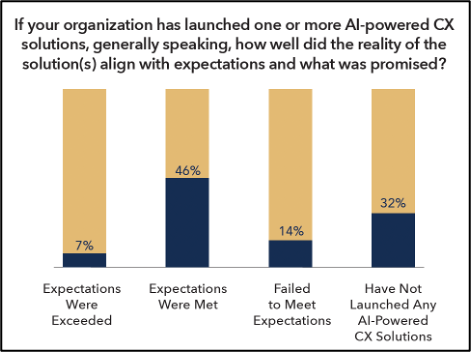Brands are turning to AI-powered solutions to stay ahead of the curve. If your organization hasn’t yet explored the potential of AI in your contact center, now is the time. Our latest report in partnership with ASAPP, The State of the Tech: AI in the Contact Center, delivers key insights into how AI is transforming CX operations. Here’s a snapshot of some exciting findings pointing to AI as a trend and a necessity for delivering superior customer interactions.
AI is Meeting—and Exceeding—Expectations
It’s no surprise that many organizations are turning to AI to enhance their customer service capabilities. According to the report, nearly 70 percent of companies implementing AI solutions found that the technology either met or exceeded expectations. Specifically, 46 percent reported their expectations were fully met, while seven percent of organizations stated that AI-powered solutions even surpassed what they had hoped for.
This is an encouraging sign for brands considering AI-driven CX—especially as AI technology continues to evolve and improve.
AI’s Impact on Customer Satisfaction is Undeniable
One of the most promising outcomes from the report is AI’s positive influence on customer satisfaction (CSAT) scores. An impressive 35 percent of companies saw a noticeable increase in their CSAT scores after integrating AI into their operations. More than half (53 percent) saw no significant change, suggesting that while AI hasn’t led to drastic CSAT improvements in all cases, it also hasn’t harmed it. This stability offers peace of mind for organizations concerned about the possible risks of AI adoption.

Customers Are Embracing AI
Customer receptiveness to AI is often a top concern when it comes to launching these technologies in contact centers. The report’s findings show that fears of customers rejecting AI-driven interactions may be overblown. In fact, 32 percent of companies reported that their customers were somewhat receptive, while eight percent stated that their customers were very receptive to AI solutions.
Only four percent of respondents reported a somewhat resistant customer reaction, indicating that customers are not only ready for AI in the contact center but are embracing it.

AI Deployment Has Just Begun—Is Your Brand Ready?
Despite the promising results from AI adopters, 32 percent of companies have yet to deploy AI-powered CX technologies. Of those that have, 29 percent said they are currently in the process of rolling out these tools, and 17 percent are still in the pilot phase. This data highlights that while many organizations are at various stages of their AI journey, there’s a substantial opportunity for those that are yet to adopt these technologies.
The Impact on Headcount
As generative AI-powered CX technologies continue to be implemented across industries, one of the major concerns for many organizations is how these advancements will impact staffing. Will AI lead to a reduction in workforce or even replace employees entirely?

According to the findings, 41 percent of organizations reported no decrease in headcount due to AI adoption, and importantly, they do not expect one in the near future. This demonstrates that while AI is indeed transformative, it doesn’t necessarily equate to fewer jobs. In fact, it is reshaping roles rather than eliminating them.
For 29 percent of organizations, there has been no decrease in headcount yet, but they do anticipate a reduction in the future. This highlights a trend where AI is gradually taking on repetitive or manual tasks, which could streamline operations and potentially reduce the need for certain roles. However, this doesn’t imply a sudden or immediate shift in staffing.
Interestingly, seven percent of companies reported that the implementation of AI actually led to an increase in headcount. As AI-powered technologies take over simple tasks, the need for more strategic, higher-level roles grows. Organizations may need to hire employees with specialized skills to manage and optimize these AI tools, as well as to focus on more complex customer interactions that require a human touch.
On the other hand, 19 percent of organizations experienced a modest decrease in staff as a result of AI deployment, while four percent saw a dramatic decrease. These companies are using AI to reduce manual workloads and may have streamlined certain functions. However, these figures show that for the majority, job displacement due to AI is not as prevalent as some might have feared.
The key takeaway? While AI is transforming how we work, it’s not necessarily leading to widespread job loss. Instead, it’s paving the way for a more efficient workforce, where AI handles routine tasks, and employees can focus on more meaningful and impactful work. If your organization is weighing the decision to adopt AI, now may be the time to consider how these technologies can complement, rather than replace, your existing team.
Expectations vs. Reality: How AI Solutions Stack Up

A closer look at organizations that have launched AI-powered CX solutions reveals a largely positive alignment between expectations and reality. A solid 46 percent reported that their expectations were fully met, and seven percent said the technology exceeded what was promised.
While 14 percent noted that AI solutions fell short of their expectations, the positive feedback far outweighs this minor percentage, underscoring AI’s potential to transform the contact center.
Ready to Dive Deeper?
These key insights from The State of the Tech: AI in the Contact Center report only scratch the surface of what AI can do for customer experience. Whether you’re considering AI for the first time or looking to expand your current AI capabilities, this report is packed with data and insights to help guide your strategy.
Download the full report today to discover the full picture and learn how your organization can capitalize on the power of AI in CX.




























































 TELUS Digital
TELUS Digital ibex delivers innovative BPO, smart digital marketing, online acquisition technology, and end-to-end customer engagement solutions to help companies acquire, engage and retain customers. ibex leverages its diverse global team and industry-leading technology, including its AI-powered ibex Wave iX solutions suite, to drive superior CX for top brands across retail, e-commerce, healthcare, fintech, utilities and logistics.
ibex delivers innovative BPO, smart digital marketing, online acquisition technology, and end-to-end customer engagement solutions to help companies acquire, engage and retain customers. ibex leverages its diverse global team and industry-leading technology, including its AI-powered ibex Wave iX solutions suite, to drive superior CX for top brands across retail, e-commerce, healthcare, fintech, utilities and logistics.






















 Trista Miller
Trista Miller




























